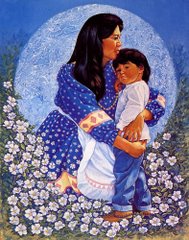Residential Schools from http://research2.csci.educ.ubc.ca/indigenation/Indian_ReACTions/Indian_ReACTions/ResidentialSchools.htm
U of T Law Professor Patrick Macklem, author of Indigenous Difference and the Constitution of Canada (2001) argues that legislation like the Indian Act (1867) established a "unique constitutional relationship...between Aboriginal people and the Canadian State" (4). He contends that "constitutional protection of interests associated with indigenous difference promotes equal and therefore just distributions of constitutional power" (5). While Macklem employs these arguments in support of First Nations rights, it is somewhat ironic that Canadian legislation, for the most part, has been instrumental in undermining aboriginal cultures. The Indian Act, for instance, made status Indians legal wards of the state. A few months after the passage of the Indian Act of 1876 Deputy Superintendent General of Indian Affairs, Lawrence Vankoughnet, wrote that "the legal status of the Indians of Canada is that of minors, with the Government as their guardians" (Harring, 262).
As wards of the Canadian State, historically the lives of status Indians have been heavily regulated. They were denied the vote until 1960; cultural ceremonies like the west coast Potlatch and the prairie Sun Dances were made illegal until a reformation of the Act in 1951; Indian women who married non-status men lost their status until the passage of Bill C-31 in 1985. But perhaps the most damaging was the establishment of the residential school system, run by local churches in collaboration with the federal government. In 1908 the Minister of Indian Affairs, Frank Oliver, identified education as the method that would "elevate the Indian from his condition of savagery" and "make him a member of the state, and eventually a citizen in good standing" (as cited in the Report of the Royal Commission on Aboriginal Peoples, Chapter 10).
The original intentions of the residential school system were three-fold:
1) to seperate youngsters from their families, communities, and "savage" culture;
2) to socialize or "civilize" these students in Western values (including Christian morality and patriotism);
3) to assimilate aboriginal peoples into mainstream society.
"By this last step, the male graduate could avail himself of the enfranchisement provisions of the Indian Act, leaving behind his Indian status and taking on the privileges and responsibilites of citizenship" (RCAP, ch.10, p. 8).
The logic then, is as follows:
Children would be isolated from their culture and "educated" in European values and cosmologies.
Upon reaching adulthood, they would not return to aboriginal communities but rather assimilate into mainstream (white) society. These graduates would give up pre-existing legal rights to the land, presumably assured through treaties, in exchange for full citizenship.
If legislation made status Indians "minors" or "wards of the state" and as such, not full and free members of society, the residential school system was intended to reinstate them as 'citizens.'
Roland Chrisjohn and Sherri Young, in the Circle Game: Shadows and Substance in the Indian Residential School Experience in Canada (1997), have argued that these intentions amount to "cultural genocide as defined by Article 2 of the UN Convention on Genocide, 1948:
Genocide means any of the following acts committed with intent to destroy,
in whole or in part, a national, ethnic, racial or religious group, as such:
(a) Killing members of the group;
(b) Causing serious bodily or mental harm to members of the group;
(c) Deliberately inflicting on the group conditions of life calculated to
bring about its physical destruction in whole or in part;
(d) Imposing measures intended to prevent births within the group,
(e) Forcibly transferring children of the group to another group."
(Indian Residential School Survivors Society)Under the residential school system, children as young as six were forced to spend the main part of the year in institutions often far removed from their families, forbidden to speak their own languages and unable to learn and follow their First Nations cultural traditions. There they were often subjected to emotional, physical and sexual abuse. Rather than become assimilated members of mainstream Canada, these former students "experienced symptoms of Post-Traumatic Stress Disorder not unlike those suffered by war veterans or police officers.
[Symptoms include] panic attacks, insomnia, uncontrollable anger, alcohol and drug use, sexual inadequacy or addiction, the inability to form intimate relationships, eating disorders" (Fournier and Crey, Stolen From Our Embrace, 63).
Because these students often lost the ability to speak in their aboriginal languages and didn't have the opportunity to learn cultural traditions or develop parenting skills, the trauma they experienced affected how they raised their children. Over the past decade many survivors have participated in healing circles to deal with the pain inflicted upon them. Key to this healing has been the fight in the courts to prosecute their abusers, seeking compensation and apologies.
As part of the healing process, many residential school survivors have told their stories, testifying about the abuses they endured. Many of these testimonies are included in the 1996 Report on the Royal Commission on Aboriginal Peoples. Many First Nations authors have gone on to write about their memories of residential school:
- In 1992, N'laka'pamux author, Dr. Shirley Sterling, wrote a fictional account, My Name is Seepeetza, based on her own experiences at the Kamloops Residential School.
- Eminent playwright and pianist Tomson Highway, in his first novel, Kiss of the Fur Queen (1998), wrote about Cree brothers, Jeremiah and Gabriel Okimasis, based on Highway's life and the life of his brother, the late René Highway.
- Anishinabe writer, Basil Johnston, author of numerous books, wrote his autobiography, Indian School Days in 1988.
These works form an emerging genre in First Nations literature that might be considered "the Residential School Memoir," one that dodges the definitions of the traditional autobiography, to tell stories, not only of the author's lives, but also to express the collective trauma of their communities. In doing so, they write not from the perspective of assimilated citizens but as aboriginal peoples with distinct collective identities.

No comments:
Post a Comment